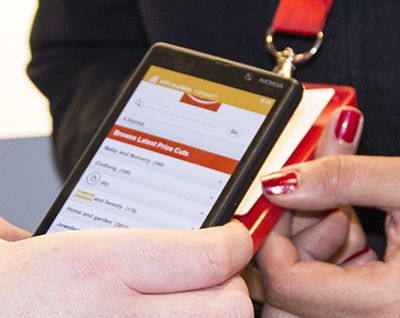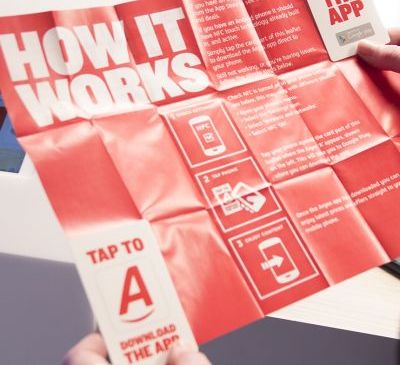Feb 14, 2014British retailer Argos is piloting an program in 40 of its approximately 750 stores that lets shoppers access the store catalog, as well as coupons and discount information by tapping touching an NFC-enabled phone to any of 88,000 "TapPoints" that incorporate Near Field Communication (NFC) RFID inlays. The solution, known as Mobile-in-Retail, is being used in the stores for an initial initiative that will last 90 days, after which Argos will gauge the results and determine whether to proceed with a larger permanent deployment.
Argos sells toys, home furnishings, personal-care items and electronics through its physical stores as well as a 2,000-page-long online product catalog. As part of a larger effort at reinventing its brand and modernizing how it reaches its customers, the retailer is attempting to link its brick-and-mortar stores with its online marketplace, and enable customers to purchase any of the company's products as efficiently as possible, as well as to access information about product discounts.

The company began working with Proxama—a mobile wallet, marketing and loyalty company based in London—about four months ago, to develop and begin testing an NFC-based solution that would let Argos engage with its customers electronically, explains Miles Quitmann, Proxama's managing director and chief commercial officer. (Argos declined to comment for this story.)
The technology was installed at 40 Argos stores by mid January, and the retailer will evaluate the results at the end of the initiative, in April. The technology relies on consumers' NFC-enabled Android-based phones and an Argos app downloaded from Google Play. The phone automatically accesses the Argos catalog of merchandise when the app is open, as well as acquires specific details about products through taps of the phone against TapPoints, made with 13.56 MHz passive NFC RFID inlays supplied by printed electronics manufacturer Kovio (acquired by Thinfilm in January). The TapPoints are embedded in posters and leaflets and in cards worn on lanyards by staff members in the 40 stores. Altogether Argos is using 88,000 TapPoints, each with an RFID tag encoded with its own unique ID number.
When customers come to one of the participating stores, they can go to a staff member who is wearing a TapPoint card on a lanyard or pick up one of the "Download the App" leaflets. The store employees are trained to identify whether an individual's phone is equipped with an NFC reader, and to instruct the customer as to how to turn on that reader. Once the NFC reader is operating, the customer taps the phone against a worker's TapPoint card to capture its tag ID number, prompting the phone to go to the Google Play site to download and install the Argos app. (The leaflets contain their own TapPoint tags and provide the same instructions in printed form that a worker does.) With the app installed on the phone, the customer can access the retailer's online catalog and begin shopping, and complete a purchase online, then pick the product up at the store or have it delivered.
However, the technology is intended to also encourage physical shopping. When walking through one of the 40 participating Argos stores, a customer will pass posters arranged around the store or products on display, with printed text inviting shoppers to tap their NFC-enabled phones to access coupons, loyalty points and further information about a product. TapPoint software resides on Proxama's own hosted server and receives the TapPoint tag identifier sent by the phone, and then returns information material and promotional offers related to that ID for display on handset's screen. To redeem a discount coupon, the customer can show that handset to the clerk at the point of sale.

Proxama not only provides marketing and loyalty solutions such as the one being tested by Argos, but also contactless payment systems. The Mobile-In-Retail solution (which does not include payment options) can be customized for each user, says Quitmann, and supports not only NFC technology but QR codes and Bluetooth beacons, allowing a retailer, for example, to use any combination of technologies that will be most appropriate for that use case. Proxama also provides analytics as needed, helping merchants to understand shopper behavior, which products are drawing the greatest interest, and other business statistics that could help them better manage how and where products are displayed.
"Our business is all about connecting to the digital world," Quitmann says.
Although Argos does not intend to release results of the initiative until after it is completed, Quitmann says his company has been pleased with the usage it has been getting from consumers, thus far. The positive response, he says, is despite the fact that only about a total of 12 million to 18 million people in the United Kingdom—approximately 15 to 20 percent of all British handset owners—currently have NFC-enabled mobile phones. However, he points out that, with the exception of the iPhone, most new smartphones being released come built-in NFC readers. Quitmann acknowledges that consumers typically require some education before they can use the technology, as they are unfamiliar with how the NFC function works. He expects consumers to be much more knowledgeable in the next few years.

